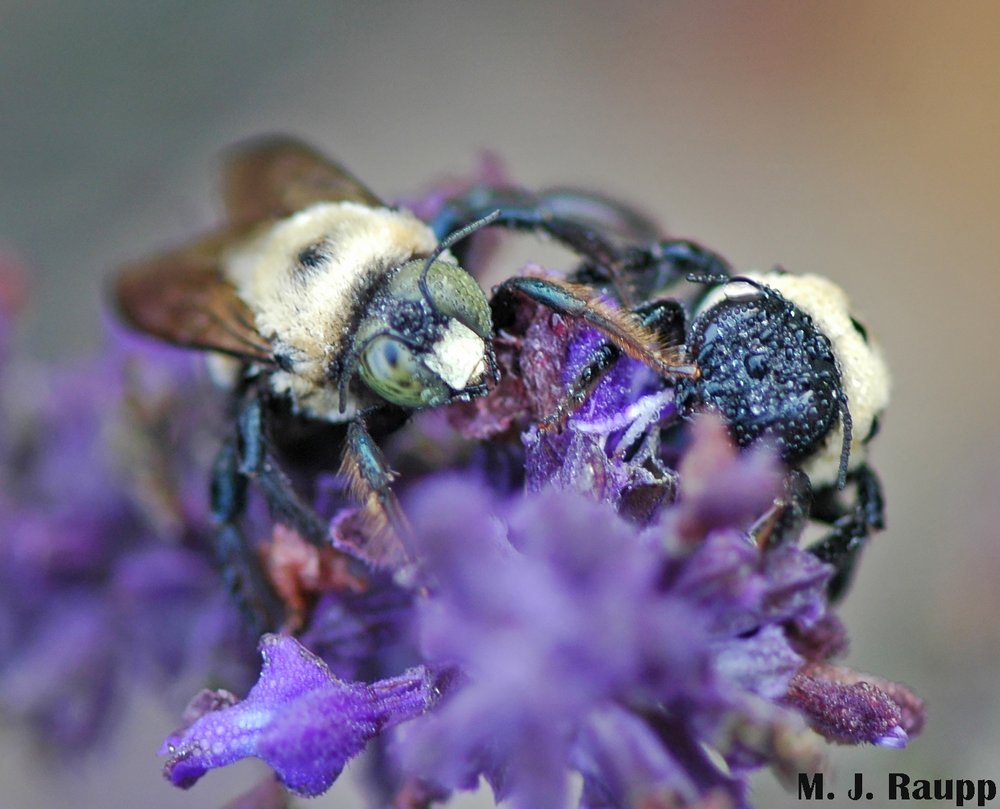
On a dewy morning, male (left) and female (right) carpenter bees await a warm-up from the brilliant autumn sun.

You may have seen the carpenter bee’s hole on the outside of your siding - here’s a look at the brood galleries on the inside.
As record warmth embraced much of the eastern seaboard in recent weeks, children and gardeners reported swarms of “large bumble bees” busily gathering nectar from late season blossoms in flower patches, as well as nature centers and flower beds in residential landscapes. While there is no doubt that many of these bee sightings were indeed bumble bees, this is also the closing act of a fresh crop of carpenter bees as they mob patches of flowers to fatten-up on floral delights in preparation for the upcoming winter. Months ago, busy female carpenter bees devoted weeks constructing galleries in wood, provisioning these galleries with pollen, and depositing eggs within these wooden nurseries. Summer and early fall were a time for young bee larvae to consume these morsels, complete their development, pupate, and emerge as adults. Galleries used as nurseries throughout spring and summer will soon serve as winter refuges for this year’s class of carpenter bees.

Note the shiny hairless abdomen of the carpenter bee.
With a little practice, carpenter bees can be distinguished from their look-alike bumble bee cousins. A carpenter bee’s rump is relatively naked whereas a bumble bee’s butt is usually quite well-cloaked with hair. The head of the carpenter bee is about the width of the thorax, the body segment just behind the head. The head of a bumble bee is noticeably smaller than thorax.

A hairy abdomen is a hallmark of the bumble bee.
Bumble bees have a hairy abdomen, carpenter bees do not. The male carpenter bee has a white patch on his face and the female’s face is entirely black. A male foraged on a lower blossom until he spotted a female foraging just above, and then both appeared to have other business on their minds as they raced away.
Having identified the bee as a carpenter bee, how does one distinguish the guys from the gals? The gender of some carpenter bees such as the large carpenter bee, Xylocopa virginica, is easily recognized by the presence or absence of a large white or yellow patch just between their compound eyes: the male sports the white patch, but the forehead of the female large carpenter bee is entirely black. On occasion I have captured large male carpenter bees with my hand to demonstrate that they are not to be feared as they have no stinger, only female bees are equipped with this notable appendage. On one occasion I mistakenly grabbed a female carpenter bee and learned the awesome power of this appendage. If for some strange reason you choose to handle large carpenter bees, please be certain that they are indeed carpenter bees and not bumble bees, and only handle the he bee and not the she bee.
If you want to see a carpenter bee up close and personal you can, but do so only if 1) you know it is a carpenter bee, and 2) it is a male bee, confirmed by the white patch between its eyes. If you try this with a female carpenter bee or a female bumble bee you will have a memorable and painful surprise when you are stung.
One quirky behavior of both carpenter bees and bumble bees comes at the end of the work day. Industrious bumble bee workers usually return to their nest at dusk with the final loads of nectar and pollen to fatten-up any future queens and drones that might still be developing in the nest. But sometimes bumble bees and carpenter bees can be found late in the day or early in the morning resting on a blossom, apparently taking a snooze. With no nest to provision or hungry future royals to feed, it is no surprise to find sleepy carpenters resting on flowers in the early light of dewy autumn mornings. One of their favorite resting spots in my garden is a patch of spotted horsemint. Members of the mint family are renowned for their ability to attract a variety of pollinating insects, in addition to their medicinal qualities. Perhaps, the lazy behavior of my carpenter bees is related not only to the nighttime chill that cools their bodies, but also to some soporific chemical found in the nectar of mint. Who knows? When the killing frost finally puts an end to my autumn bloomers, the last of the carpenter bees will enter the brood galleries not to return until next spring. On a cool autumn morning or a warm afternoon take an early trip to the flower garden to visit the newly minted class of 2023.
Acknowledgements
Bug of the Week thanks Jackie, MPT, University of Maryland Master Gardeners, and the Howard Conservancy for providing the inspiration for this episode. The really cool bee book “The Bees in Your Backyard: A Guide to North America’s Bees” by J. S. Wilson and O.M. Carril was used as a resource for this episode.
No comments:
Post a Comment